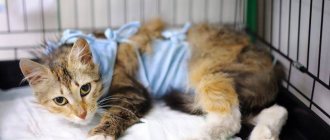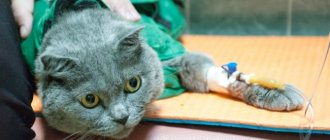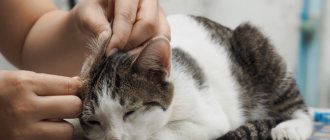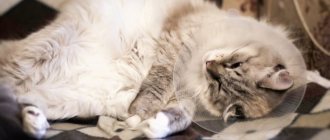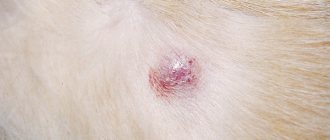Types of bumps on cats' paws and their causes
Despite the fact that the types of bumps on cats’ paws and their causes vary greatly, even a not very “veterinarian” owner, after taking a good look, will be able to at least roughly guess the nature of the neoplasm and how urgently it is necessary to seek veterinary help.
Main pathogenic factors:
- Cones of purulent origin. If a splinter (grass stubble, for example) gets under the skin on the paw, then the pathogenic and conditionally pathogenic microflora located on its surface gradually causes inflammation. However, an abscess that appears as a result of bites is much more typical. Because there is no access to oxygen; over time, a lump filled with purulent exudate forms in this place.
- Pyoderma, which occurs as a result of severe deterioration of immunity and contamination of the skin with streptococci or staphylococci. However, neoplasms with pyoderma rarely develop to the point of large lumps. As a rule, such “pimples” are no larger in size than a large cherry. In addition, they are numerous, and therefore it is extremely difficult to mistake them for a single cone.
- Strong blows ending in the formation of a hematoma. In these cases, small (and other) blood vessels “explode” under the skin, as a result of which the newly formed cavity is gradually filled with blood. A separate and rare variety is “lymphotomes”, i.e. similar neoplasms that appear as a result of damage to the lymphatic vessels. If the skin is damaged, the hematoma may be complicated by the development of purulent inflammation.
- Edema. Such bumps also appear suddenly, and they are not easy to detect visually. Much more often their appearance is diagnosed by palpation of the cat's paw.
- Benign neoplasms (tumors). They are generally quite soft and slow growing. Most often, they appear in old cats, and their occurrence cannot be called rapid: such tumors can grow for years.
- Cases of the formation of large warts and papillomas can be considered a type of benign formations. They bear little resemblance to “typical” cones, since in this case there is a clearly defined neck and body of the neoplasm, which is why the latter often dangles on the cat’s paw, resembling a small, leathery “pendulum.”
- Malignant neoplasms (cancer). In this case, the tumors are tougher, grow many times faster, and sometimes their appearance takes several weeks. This reason for the formation of cones is extremely dangerous, because... Through metastasis, tumors can quickly spread throughout the body.
- Poisonous insect bites, poisonous herb burns. Of course, such cones are found either only in the summer, or exclusively in the southern regions. They arise spontaneously, very quickly. Often accompanied by the development of allergic reactions. If the dose of poison was large, or if the cat is susceptible to the poison that entered its body, the pet may well die.
- If the lump appears somewhere in the area of the fingers, you can suspect that the animal has a fungal or yeast infection (malasseziosis, for example). In cats, such diseases are somewhat less common than when compared with dogs, but such cases do exist. A characteristic sign of these ailments is a sharp, specific smell. Sometimes it resembles the aroma of cheese or mold, but sometimes the paws of a sick cat can noticeably “smell” like old socks.
- Lumps of a cystic nature. Typically, cysts (fluid-filled blisters) appear in internal organs, but there are also more rare cases of their formation on the paws or other surfaces of the body. They grow rather slowly, but their appearance causes a lot of trouble for the animal: they hurt a lot, itch, which is why the cat constantly scratches them or even chews them until they bleed. This process is often supplemented by the participation of pathogenic pyogenic or necrotic microflora.
- Lump in the joint area. In most cases, this happens either after severe injuries (falls, bruises, a cat falling under the wheels of a vehicle), or against the background of old, advanced cases of arthritis and arthrosis. In this case, the cat’s joint capsule is destroyed, and the synovial fluid immediately or gradually flows under the skin. The process is similar to the principle of hematoma formation.
- The lump may be a consequence of edema, including an allergic nature. Considering that even relatively harmless urticaria can cause anaphylactic shock, it is better to immediately show the cat to a veterinarian.
- Finally, the lump can develop from the inside, i.e. be the result of growths on the bone itself. This can be a consequence of poorly healed fractures, or, what is much worse, it can be a sign of sarcomas, osteoblasts and other oncological pathologies of bone tissue.
First aid if a cat has a swollen paw
The actions of a cat owner vary depending on the main symptom. What is the nature of the damage? Is your pet holding his paw up and unable to step on it, or is he just limping?
Be sure to read:
What causes growths on the pads of cats' front or hind paws?
The cat's paw is swollen and cannot step on: what to do?
The cause of the pathology is a cut or puncture wound caused by sharp objects or a bent claw that has grown into the pad of the finger. Alternatively, a splinter.
In such cases, cut off the claw or remove the foreign object embedded in the paw, and treat the wound with an antiseptic spray. Observe the pet’s behavior, palpate the paw to identify pain, as well as local hyperthermia. If the condition does not improve within a day, call the veterinarian.
The cat has a swollen paw and is limping: what to do?
In this case, it is necessary to exclude a traumatic cause of the disease, and also take into account the age of the pet. If both hind legs swell and your cat is not in pain, he most likely has a chronic disease. Older pets get sick more often than younger ones because they are susceptible to heart, kidney or liver failure.
In this situation, the owner is unable to help, so it is necessary to entrust the treatment to a professional.
First aid and treatment for cats
As a rule, first aid and treatment of a cat in such cases is the prerogative of a veterinarian. We can advise the owners themselves the following:
- It is necessary to immediately provide the animal with complete rest; if necessary, it should be isolated from other pets and small children.
- If the lump has formed suddenly, you can apply cold in the first half hour to an hour. Do not use warming or cooling ointments.
- To make paw care and treatment easier, you can clip the hair around the coat.
- If pus or other exudate is released from the neoplasm, it must be regularly removed from the skin.
How to treat if a cat has a swollen paw
If a cat has mechanical damage as a result of a cut, bite, embedded splinter, dislocation or fracture, it is necessary to fix the paw and apply cold. Subsequent actions must be entrusted to a specialist. The veterinarian will determine the cause of the pathology visually or using instrumental studies (X-rays, etc.).
The specialist will straighten the dislocation, apply stitches, bandage it, and prescribe antibiotics. Further actions of the owner are aimed at fulfilling the doctor’s orders.
In some cases, an allergic reaction develops to an insect bite. Only one paw is affected, mainly the front one, swelling develops at the site of the bite, and the local temperature rises. If the pathological symptom does not go away within a few hours, veterinary attention will be required. The veterinarian will administer an antihistamine and the swelling will subside.
Arthritis develops mainly in older pets. The reason is a metabolic disorder due to an unbalanced diet. Obesity and chronic diseases develop. One or both hip joints are swollen, painful, hot, and the skin is tense.
The main task of the veterinarian is to reduce pain.
The treatment is long-term, complex, and develops in the following areas:
- drug therapy using anti-inflammatory drugs and antibiotics;
- therapeutic diet using ready-made food for cats with joint diseases;
- physiotherapy.
Be sure to read:
How to understand that a cat is sick: external signs, how the animal behaves, clear signs of illness, what to do
One of the pathological symptoms of heart, liver, and kidney failure is symmetrical swelling of the paws. They suffer. mainly older pets. The disease is incurable. Symptomatic treatment allows you to maintain your pet’s well-being at a satisfactory level.
Lymphadenitis is inflammation of the lymph nodes. Develops as a complication of an infectious disease. The lymph nodes are enlarged and can be detected by palpation. The swelling extends only to the front legs and is accompanied by lameness. If the underlying disease is treated, the lymph nodes will shrink and the swelling will subside.
Most often, cancer affects the mammary glands of an older cat. The swelling extends to the hind legs. Animals whose owners abuse hormonal contraceptives become ill. Treatment is symptomatic, supportive, the prognosis is unfavorable.
Prevention and hygiene of animal paws
Prevention and hygiene of cat paws plays an important role:
- If your pet is walking outside, it doesn’t hurt to inspect its paws from time to time. If they are dirty, wash them with warm water and baby soap.
- Cats should be given the opportunity to naturally grind down overgrown claws (using scratching posts). If this is not possible, overgrown claws are trimmed from time to time.
- The pet should be vaccinated in a timely manner and undergo a preventive veterinary examination at least once a quarter.
What is "cutaneous horn"?
New growths on the paws near the claws are called “cutaneous horn”. This name is due to the fact that the growths usually have a dense structure and resemble an extra claw. They are nothing more than tissue proliferation due to keratinization. The causes of the formation of such growths are in most cases viral.
The growths on the paws of Brittanys and other breeds are usually a different color from the paw pads and nails. They can be light, almost white, or dark brown. Their nature is in many ways similar to ordinary warts. Growths are also caused by papillomavirus, of which there are several dozen. Leukemia can also provoke proliferation and keratinization (excessive formation of keratin in the epidermis).
The growth itself is in most cases not dangerous and does not cause discomfort to the pet. However, neoplasms require careful monitoring. You should show the animal to a veterinarian and conduct a series of examinations to confirm the benign nature of the growth.
Diagnosis by the appearance of the lump
As we have already written, diagnosis by the appearance of the lump is quite possible. But for successful diagnosis, it is necessary to pay very close attention to both the appearance of the neoplasm and its consistency.
The smell also plays a big role, even if it is often far from the most pleasant.
soft bump
If the lump is soft, its causes may be:
- Purulent inflammation.
- Hematoma in the initial stage, release of synovial fluid, pyoderma.
- Soft bumps are benign tumors. This is especially true for large warts and papillomas.
Reasons for the formation of growths
As mentioned above, growths are most often a consequence of the activity of the papillomavirus. Animals are susceptible to this disease to the same extent as people. Infection with the virus occurs against a background of weakening of the body.
Indirect causes of the appearance of tumors on the paws can be considered:
- Decreased immunity.
- Metabolic disorder.
- Elderly age.
- Viral diseases.
- Claw injuries.
Separately, oncological diseases are identified as the cause of the appearance of growths. In cancer, the “skin horn” is a consequence of systemic disorders in the body. Also, growths can appear in response to chemotherapy and other drugs for the treatment of cancer. This is associated with a decline in immunity.
You might be interested in: Why are Britons constantly in tears?
Severe damage to the claw, for example, as a result of a conflict with a relative or a blow, can lead to the appearance of growths on the cat’s paws. This is explained by the fact that at the site of injury, intensive release of keratin begins and the rate of division of epidermal cells changes, which leads to the formation of the so-called second claw.
Another cause of “cutaneous horn” is keratosis. The disease is characterized by the formation of areas of keratinized epidermis. Such areas differ in color from healthy skin, the epidermis becomes hard and rough, and peeling is possible. Keratosis is a consequence of the negative effects of household chemicals or sunlight on an area of the skin. Epidermal disease can develop after injuries, burns or prolonged contact with chemicals.
Treatment
There is no treatment that can eliminate the disease once and for all.
Cats with this problem are prescribed maintenance therapy, which can improve quality of life. However, it does not always improve so much that the pet can at least walk. In cats showing early signs of the disease, pain can be controlled with nonsteroidal anti-inflammatory drugs. Chondroprotectors are also prescribed, most often glucosamine and chondroitin sulfate. They are believed to help reduce cartilage degeneration and increase the amount of joint fluid. However, there are no studies that would confirm this 100%. However, doctors still prescribe these drugs because... The choice of treatment methods for OCD is, in principle, small.
A number of veterinary experts advise using, among others, homeopathic medicines for chondrodysplasia: “Coenzyme compositum” (used for inflammatory and degenerative diseases) and “Discus compositum” (has metabolic, regenerative, analgesic, anti-inflammatory, antispasmodic and sedative effects).
Manual therapy with massage has also proven itself well, but it must be carried out by a professional.
In severe cases, surgery (osteotomy and arthrodesis) is indicated. The operation can give very good results if there are indications for it.
Radiation therapy in the treatment of OCD
There is also an experimental treatment originally from England, where such cats are irradiated. Similar experiments are being carried out in Japan. Radiation therapy has already been proven effective in certain individuals: it relieves pain and prevents further destruction of the joints. However, the problem is that such treatment is practiced in few places, and our clinics do not have the necessary equipment.
“In medicine, low-dose radiation therapy is usually used to treat inflammatory and degenerative diseases. Although the mechanisms of the analgesic effect have not yet been clarified, they are suggested to be related to the anti-inflammatory effect. Radiation is considered a promising treatment option for osteochondrodysplasia, but long-term evaluation of its effectiveness and late complications has not been adequately assessed. There is insufficient information on the clinical use of this treatment. Further studies with a larger sample size and longer follow-up period are required,” concluded the Japanese doctors who conducted the study.
It is worth noting that radiation therapy is still largely an attempt to relieve pain and slow down the progression of dysplasia for seriously ill animals. However, if it was possible to stop the pain syndrome in all cases, then it was not possible to stop the progression of the disease. There is still a lot of uncertainty in this technique.
